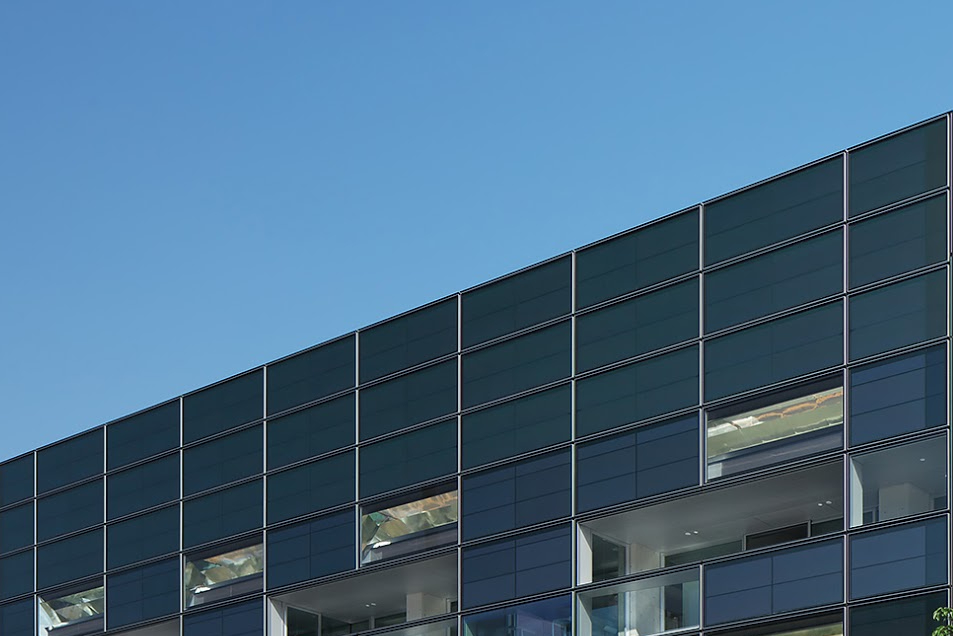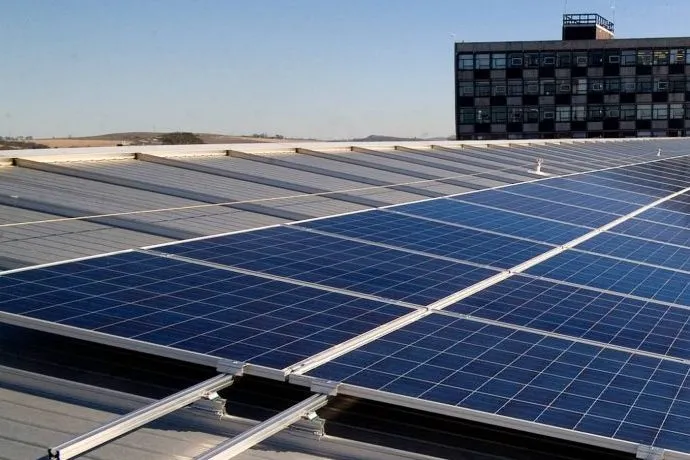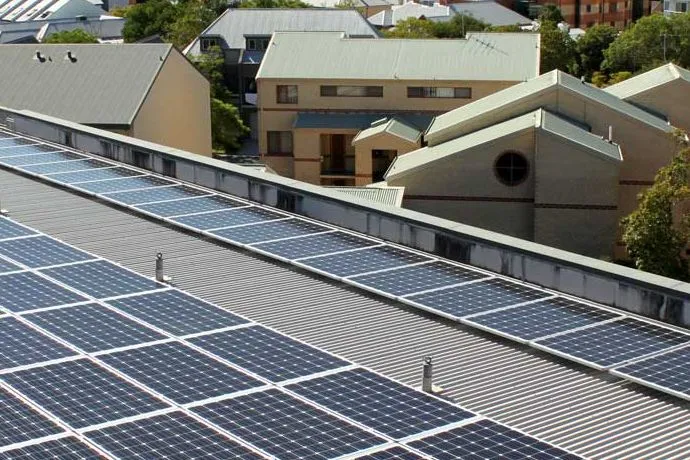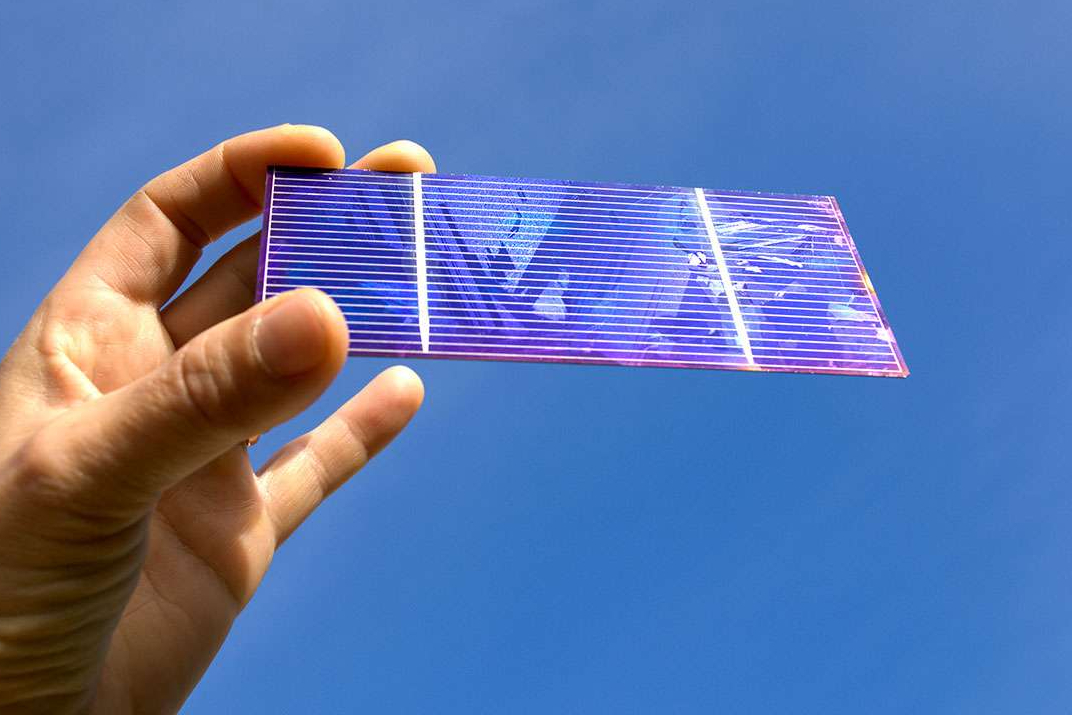What are commercial solar panels?
Commercial solar panels are a key component of solar power systems for commercial and industrial use.
They usually consist of multiple solar cells that convert sunlight into electricity. Although modern solar power has been around for decades, many commercial enterprises still rely on electricity. However, switching to solar power can not only save money for businesses, government agencies, and nonprofit organizations, but it can also significantly reduce their carbon footprint.
Like residential solar options, commercial solar panels harness the power of sunlight, turning this renewable source of energy into electricity that powers office buildings, factories, warehouses, and more.

Benefits of Commercial Solar Panels
1. Saves Money, Cuts Operational Costs
Electricity is one of the biggest ongoing expenses that commercial buildings have. Solar panels significantly reduce energy costs. While the initial investment can be high, over time the cost of installing solar panels is recouped by the money saved on electricity bills.
2. Gives Access to Tax Breaks
There are two tax federal credits available for businesses, nonprofits, and local and tribal governments that purchase solar energy systems:
The investment tax credit (ITC) reduces the federal income tax liability for a percentage of the cost of a solar system that is installed during the tax year.
The production tax credit (PTC) is a per kilowatt-hour (kWh) tax credit for electricity generated by solar and other qualifying technologies for the first 10 years of a system’s operation. It reduces the federal income tax liability and is adjusted annually for inflation.
Solar systems that are placed in service in 2022 or later and begin construction before 2033 are eligible for a 30% ITC or a 2.6 ¢/kWh PTC if they meet labor requirements issued by the Treasury Department or are under 1 megawatt (MW) in size.
3. It Protects Against Power Outages
Buildings that rely entirely on electric grids are vulnerable to power outages that occur during bad weather or electrical system malfunctions. Solar panels for commercial buildings with battery systems allows commercial buildings to continue to function during power outages.
Read also: Life Sciences Construction: A Rapidly Changing Landscape
4. Low Maintenance Costs
Solar panels require very little maintenance throughout their lifespan–a wash every once in a while, depending on where you live and how much debris accumulates on the panels. They have no moving parts, so they’re not likely to break down. Made of tempered glass and non-corrosive aluminum frames, solar panels for commercial buildings can withstand rain, wind, hail, and snow. The photovoltaic cells are designed to last 25 years or more.

Commercial Solar Panels Installation
The steps involved in a commercial solar panels installation typically include the following major stages:
Planning and Design: First, a site assessment is required to determine the optimal location and layout of the solar panels. Then, design a system that fits your energy needs and budget.
Obtain permits and approvals: Before installing solar panels, you will need to obtain the required permits and approvals to ensure compliance with local building codes and environmental regulations.
Procurement of materials and equipment: Purchasing required solar panels, brackets, inverters, and other related equipment according to design specifications.
Mounting brackets and panels: Install the bracket structure on the roof or the ground and mount the solar panels for commercial buildings on it. Make sure all components are secured securely against wind and other natural elements.
Install the electrical system: Install the electrical connections between the inverter and the panels to ensure that the electrical energy is converted from the solar panels into usable electricity.
Connecting to the grid: If you plan to inject solar power into the grid, you will need to install the required grid connection equipment so that excess electricity can be sold to the utility or used by other users.
Testing and debugging: Before the system is launched, the necessary testing and debugging are carried out to ensure that everything is functioning properly.
Regular maintenance: Solar panel systems require regular maintenance, which includes cleaning the panels, and checking the condition of wires and components.
Where can commercial solar panels be installed?
Commercial solar panels can be installed in a variety of locations, for example
- Rooftops: Rooftops are the most common location for solar panels for commercial buildings as they can make use of free space, do not take up land resources, and do not detract from the appearance of the building. Rooftop solar systems can be divided into two types: flat roofs and pitched roofs. Depending on the material, area, orientation, and inclination of the roof, the appropriate mounting and fixing method is chosen.
- Ground level: Ground level is another common location for commercial solar panel installations and is suitable for businesses or organizations that have a large amount of available land. Ground-mounted solar systems can be selected with fixed or tracking mounts depending on the terrain and sunlight conditions to improve power generation efficiency.
- Car parks: Solar carports are a combination of practical and aesthetically pleasing locations for commercial solar panel installations. They provide shade and protection from the rain, while also generating clean electricity. Car park solar systems are often mounted in steel or aluminum structures to harmonize with the design style of the car park.
- Agriculture: Agriculture is a location full of ideas and potential for commercial solar panel installations. They can be combined with crops, livestock, solar-powered electric fence, or aquaculture to create a win-win model. Agricultural solar systems can be selected with the right height, spacing, and angle for light and ventilation, depending on the type of agriculture.

4 Considerations When Buying Commercial Solar Panels
When you’re trying to figure out the right solar panels for your commercial business, there are many factors to keep in mind during the process. You first need to be familiar with solar panels and how they work, although you don’t have to know their specifics.
Solar panels harness sunlight to generate electricity by using photovoltaic cells to convert sunlight into usable electricity. You’ll need to place them on the roof of a building or around your house; they need to be in a sunny spot.
assessment facility
Finding the right solar panels to meet your business needs in solar requires an appraisal of the property. You can work with a solar professional who can determine if your building is suitable for solar. They can also make recommendations based on the amount of space you have and where your building is relative to the sun.
Know the size
You also need to understand the size and why it matters to your solar setup. In some cases, you may notice an increase in inverter size, which may exaggerate the power of your system. Inverters are not one-size-fits-all, so you need to consider other aspects when it comes to energy production and capacity as well as performance. In this case, your best bet is to talk to a solar expert.
panel quality
When you compare solar panels, you need to look at their efficiency as well as the efficiency of the inverter. Even though you might want to keep an eye on the efficiency of your solar panels, that doesn’t tell you how much energy your system will produce. The more efficient your inverter, the more electricity your commercial solar can generate and the lower your electricity costs.
Shade tolerance
If your roof is in the shade, you won’t get as much energy, and your panels won’t be as efficient. You may see panels marked as shade-tolerant, but regardless, your panels should only be exposed to minimal shade at any one time. This is one of the reasons why it is extremely important to work with a professional because if it is not set up properly, you will find that the system is extremely inefficient.
When you’re installing commercial solar panels on your building, keep these considerations in mind if you want to make sure your system is as efficient and efficient as possible.

Commercial solar panel rebates, tax credits, and other incentives
To encourage more businesses and organizations to use commercial solar panels, countries, and regions have developed many rebates, tax credits, and other incentives to reduce the cost and increase the return on commercial solar panels. The following are some common policies and incentives:
National Solar Investment Tax Credit (ITC): This is a tax credit offered by the US federal government that allows owners of commercial solar systems to deduct 26% of the cost of their system as income tax in the first year. This policy will be reduced to 22% in 2023 and eliminated after 2024.
Net metering (NEM): This is an electricity billing mechanism that allows owners of commercial solar systems to sell their excess electricity to the grid and receive a corresponding credit or cash payment for the electricity at or near the retail price. This mechanism can be effective in reducing operating costs and increasing the profitability of commercial solar systems. Different states and territories have different net metering rules and restrictions that need to be carefully understood and applied.
Renewable Energy Certificates (RECs): This is a market-based incentive that allows owners of commercial solar systems to receive certificates based on the amount of renewable energy they generate and sell them to entities that need to meet renewable energy targets or obligations, such as electric utilities or government agencies. Such mechanisms can provide an additional source of income for owners of commercial solar systems and facilitate the development of renewable energy markets. Different countries and regions have different types of RECs and prices, which require careful understanding and participation.
Other subsidies and loans: In addition to the three main policies and incentives mentioned above, there are some other subsidies and loans that can help owners of commercial solar systems to reduce their initial investment or operating costs. For example, in some areas there are cash subsidies, discounts, or buy-back schemes offered by local or utility companies; in others, there are low or no-interest loans, guarantees, or leases offered by green banks or community development financial institutions.
Commercial solar panel cost
- The average cost of commercial solar panels ranges from $50,000 to $600,000, depending on the system size and the installation company.
- The cost per watt of commercial solar panels is typically between $1 and $2, depending on the scale and efficiency of the system.
- The cost of commercial solar panels can be reduced by various incentives and benefits, such as the solar tax credit, the electric bill offset, the MACRS depreciation, the multiple financing options, the generation-consumption alignment, the quick payback period, and the green credentials.
Residential vs. Commercial Solar Panels
There are several key differences between residential solar panels and commercial solar panels:
- Size and power: Residential solar panels are typically smaller and less powerful than commercial solar panels, typically between 200 watts and 400 watts. Commercial solar panels are typically larger and more powerful than residential solar panels, typically between 400 and 600 watts.
- Location and mounting: Residential solar panels are usually mounted on sloping roofs and fixed using roof hooks or roof brackets. Commercial solar panels are usually mounted on flat roofs, on the ground, in car parks, or on agricultural premises and are fixed or tracked using different types and materials of brackets.
- Type of inverter: Residential solar panels usually use a tandem inverter or micro-inverter to convert direct current to alternating current. Commercial solar panels usually use a central inverter or optimizer to convert DC to AC.
- Electrical connection: Residential solar panels are typically connected to the home’s electrical switchboard and grid using single-phase electricity. Commercial solar panels are usually connected to the commercial switchboard and grid using three-phase electricity.
- Policies and incentives: Both residential and commercial solar panels are eligible for policies and incentives such as the National Solar Investment Tax Credit (ITC) and Net Metering (NEM), but commercial solar panels are also eligible for policies and incentives such as Renewable Energy Certificates (RECs) and other subsidies and loans.
Commercial Solar Panels Manufacturer
Choosing a professional and reliable commercial solar panel manufacturer is one of the key steps in installing commercial solar panels.
Sungold Solar, a solar panel manufacturer tm based in Shenzhen, China, was founded in 2008 and has 15 years of experience in manufacturing solar panels, guiding the PV industry’s continued growth and innovation with the superior reliability and durability of its products, which are sold worldwide. With reliable quality and durability, the solar panels produced by the company have passed several international authoritative certifications such as TUV, UL, FCC, CE, RoHS, and so on. They have also passed several rigorous tests, such as salt spray resistance test, tread resistance test, hail resistance test, and impact resistance test. It is suitable for applications such as rooftop, RV, yacht, camping, outdoor applications, balcony systems, and off-grid systems.
FAQ
How are commercial solar panels installed?
Commercial solar panels are typically installed using heavy weights (ballasted racking) to secure them on flat roofs or with roof-penetrating hardware (attached racking) on sloping roofs. Given the size and the nature of these installations, trained professionals are required to put them in place.
How do you size a commercial solar system?
Though commercial solar systems are complicated to install, figuring out how large a system you need is actually not too difficult. To do it, multiply your business’s hourly energy needs by the number of hours of peak sunlight in your area. Then, divide that number by a panel’s wattage to determine how many total watts you’ll need for your commercial solar system.
How many solar panels do I need for commercial use?
Once you figure out how large your commercial solar system needs to be, you can divide the total wattage by the wattage of the individual panels. Depending on the size of these panels, this will determine how many of each you will need.
Is there a difference between commercial and residential solar panels?
Commercial and residential solar panels are similar in that they both absorb sunlight that is transformed into energy. However, like most commercial products and applications, everything is done on a larger scale than those for residences. Commercial panels will likely be larger/have more wattage than residential solar panels.
Do commercial solar panel cleaning?
Regular maintenance is key to keeping any investment running smoothly. This is especially true for solar systems, where routine inspections and cleaning can allow the panels to produce more energy. If ignored, dust, dirt and grime can stain panels, block light and reduce power generation











